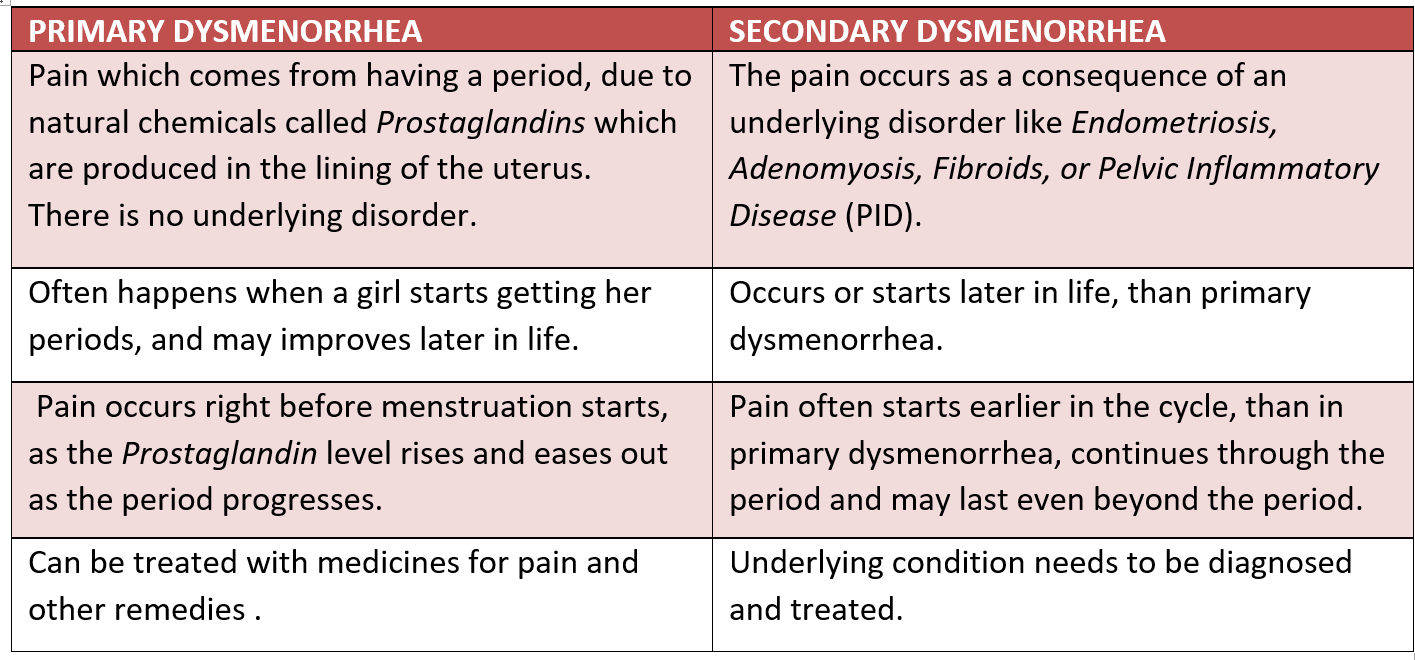What is Dysmenorrhea?
Dysmenorrhea is the term given for period pain (also called menstrual cramps). It is an extremely common condition, and many women suffer from it in varying degrees. It is different from Premenstrual syndrome.
Types of Dysmenorrhea



Symptoms of Dysmenorrhea
- Pain in the lower back and lower abdomen which may also spread to the legs. The pain may come and go or be present as a dull constant ache.
- Dysmenorrhea may also be associated with headaches.
- If the pain is very severe, it can cause fainting.
- Nausea, vomiting may accompany.
- Digestive disturbances like diarrhea or constipation may be associated.
- Premenstrual symptoms like bloating and breast tenderness may be present.
Tests done for Dysmenorrhea
- Detailed medical history is taken by the health care provider.
- Pelvic examination is done. A pelvic examination is a physical examination done by a Gynecologist through the vaginal opening to assess the female genital organs (vulva, vagina, cervix, uterus, and the adnexa -ovary, and tubes).
- Ultrasonography of the pelvis to rule out or pick up any underlying conditions is recommended.
- Laparoscopy, in severe cases where the cause is not identified, may be necessary for the diagnosis (an instrument called a laparoscope is inserted through a keyhole incision to look at the abdominal organs).
Managing Dysmenorrhea
Here we will talk only about the treatment of primary dysmenorrhea. To treat secondary dysmenorrhea, the underlying condition needs to be treated.
Painful periods can be distressful for women impacting them not only physically but emotionally and occupationally. Tackling it involves solutions combining lifestyle modification and appropriate medicines.
Diet
- Avoid foods that cause bloating and water retention, such as fatty foods, aerated drinks, salty foods, canned foods, fried foods, and dairy products.
- Avoid a diet of refined carbs like sugar, bread, and pasta.
- Caffeine (contained in tea, coffee, chocolate, energy drinks, etc.) may make period pain worse and these foods are best avoided.
- Hydrate well. Have lots of water, at least 2 liters/day.
- Chamomile tea may help to soothe nerves and improve the mood. Ginger tea may help to relieve bloating.
- Bananas and green leafy vegetables may help because their magnesium content helps to relax the uterus. Magnesium is also contained in almonds, cashews, peanuts, and black beans.
- Curcumin (found in turmeric), because of its anti-inflammatory properties is said to help to reduce menstrual cramps.
Lifestyle
- Regular exercise and physical activity throughout the month helps reduce the intensity of dysmenorrhea as opposed to a sedentary lifestyle.
- Relaxation techniques like deep breathing, mindfulness, and rest during the pain can also have beneficial effects.
- The application of a hot water bag on the abdomen can also provide some relief.
Medicines
- Pain killers of the non-steroidal anti-inflammatory drug class (NSAIDs) may be prescribed by the health care provider (like mefenamic acid, ibuprofen, diclofenac, paracetamol, etc). Some are available over the counter.
- Sometimes drugs that reduce muscle spasms (antispasmodics) may also be prescribed. (like drotaverine, dicyclomine)
- Oral combined contraceptive pills work by suppressing ovulation, reducing prostaglandin levels and also decreasing blood flow. This is considered in women who are not looking to conceive.
- Calcium, vitamin D, fish oil (containing omega 3 unsaturated fats), vitamin E and vitamin B1, B12 supplements have been used to reduce the intensity of cramps.
Dr. Ashwini Nabar is a Consultant Gynaecologist & Obstetrician practicing in the Mumbai suburbs of Bandra West and Andheri West for the last twenty years. She is affiliated with Hinduja Healthcare Surgical hospital at Khar, Lilavati Hospital and Thunga STH Hospital in Andheri. She is proficient in performing minimally invasive surgeries, including Laparoscopies, Hysteroscopies, and Robot-assisted surgeries. Ethical considerations in the best interest of the patient are the cornerstone of her practice.
Also read –
Ovarian Cysts: Understanding Causes, Diagnosis and Implications


